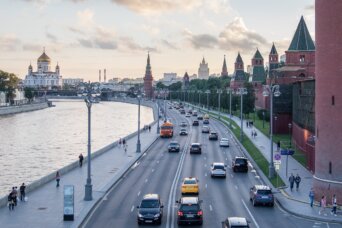- About
- Topics
- Picks
- Audio
- Story
- In-Depth
- Opinion
- News
- Donate
- Signup for our newsletterOur Editors' Best Picks.Send
Read, Debate: Engage.
| topic: | Air Pollution |
|---|---|
| located: | Russia |
| editor: | Igor Serebryany |
Russia's capital city of Moscow, once one of the most polluted cities in the country, moved to 16th place in the rating compiled by a network of professional audit, valuation and consulting firms Finexpertiza.
According to the report, the most polluted region in Russia was Krasnoyarsk territory with 2.6 million tons of various pollutants emitted there in 2019. This is the same region where the two of the largest ecological disasters happened in May and June 2020 when over 21,000 tons of oil and toxic waste spilt into the lakes around the Norilsk Nikel mining giant.
Meanwhile, the city of Moscow inflicted damage to the environment of 'only' 0.41 million tons, mostly of carbon dioxide, as public, commercial and private transport contributed 80 per cent of that amount.
The environmental check-up conducted by the city's ecological watchdog Mosecomonitoring in March and April 2020 demonstrated that air in Moscow, Europe's largest megapolis, became 1.5 times cleaner than a year ago.
Environmentalists are split over the cause of such a sharp improvement. While some of them contribute the positive trend of coronavirus lockdown, which effectively grounded nearly all private cars and many of commercial vehicles in the city for several months, others argue that it was due to changes in the methodology used by the environmental watchdog. They believe that the actual decrease in pollution has been less steep in absolute numbers and the sharp difference year-on-year was caused by a different base for calculations.
Still, there are signs that Moscow's environment has been moving to the right direction whatever the sceptics say.
This is true that Moscow city authorities have been steadily squeezing older cars out of the city limits. The Moscow public transportation department insistently toughens restrictions for cars equipped with substandard (under-Euro-4) engines – that is, all cars older than 10 years. Their owners have to pay prohibitive environmental and road taxes. Besides, since September 2018, the public transportation department started a push to fully replace petrol-driven buses with their "green" substitutes, electric buses. Currently, there are 450 "e-buses" operating on 13 routes.
Additionally, city hall restricts entry to Moscow's central areas for heavy trucks. In recent years, the federal government financed the construction of the so-called TsKAD – a 521-kilometre multilane ring highway which will allow all transit traffic to bypass the capital at the environmentally safe 50-km distance from its boundaries. The completion of the $500-million project is expected by 2025.
Surprisingly, ahead of Moscow – with its 2 million locally registered cars – stays Russia's major resort territory, Krasnodar region which emitted 0.49 million tons of pollutants. It's hard to believe, but the 2014 Winter Olympics host city Sochi, which is located in that region, has been given one of the lowest (that is, environmentally cleanest) positions in the rating. The least polluted city among those included in the list was Sevastopol in Crimea, but its belonging to Russia has been arguable.
